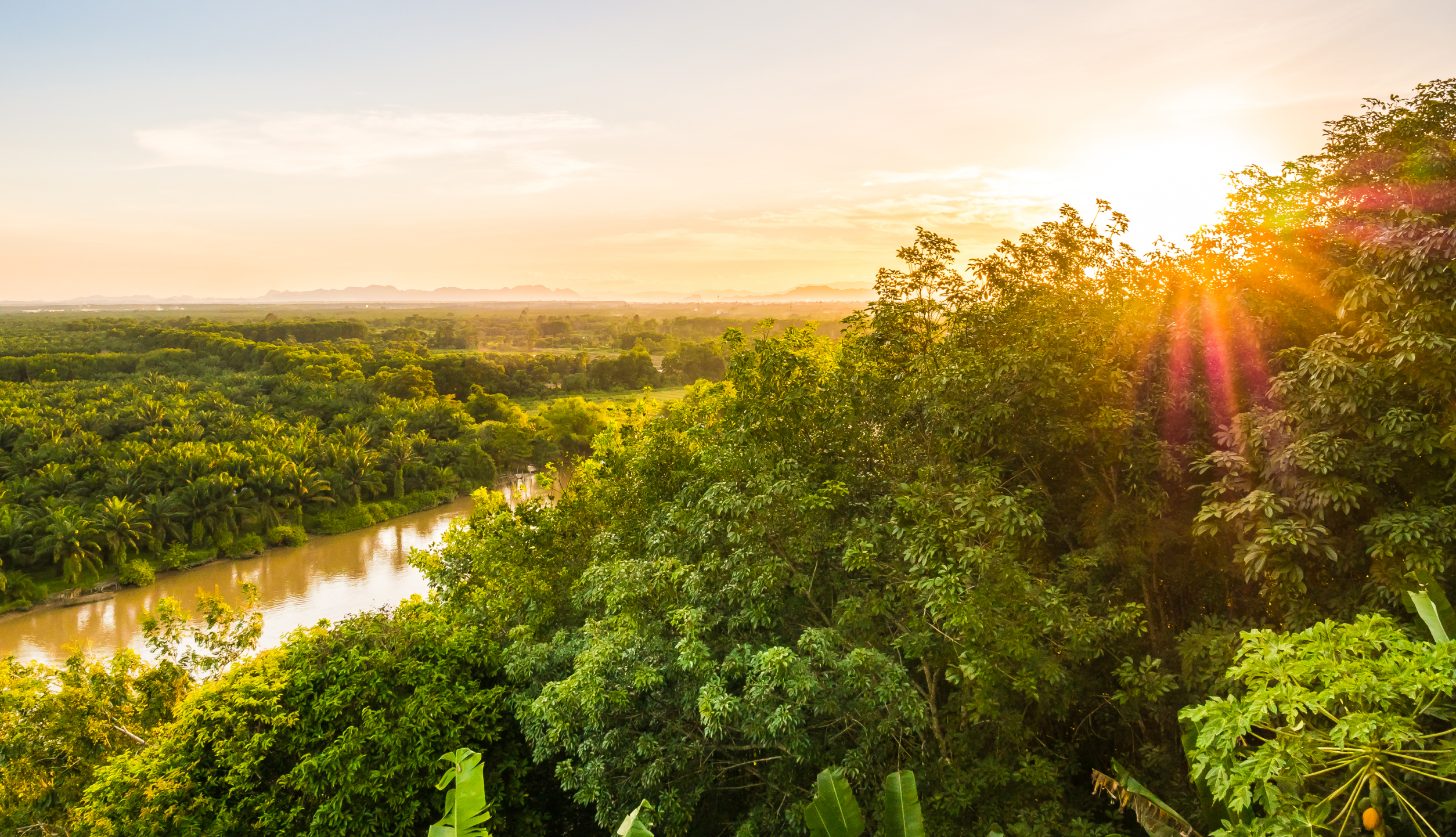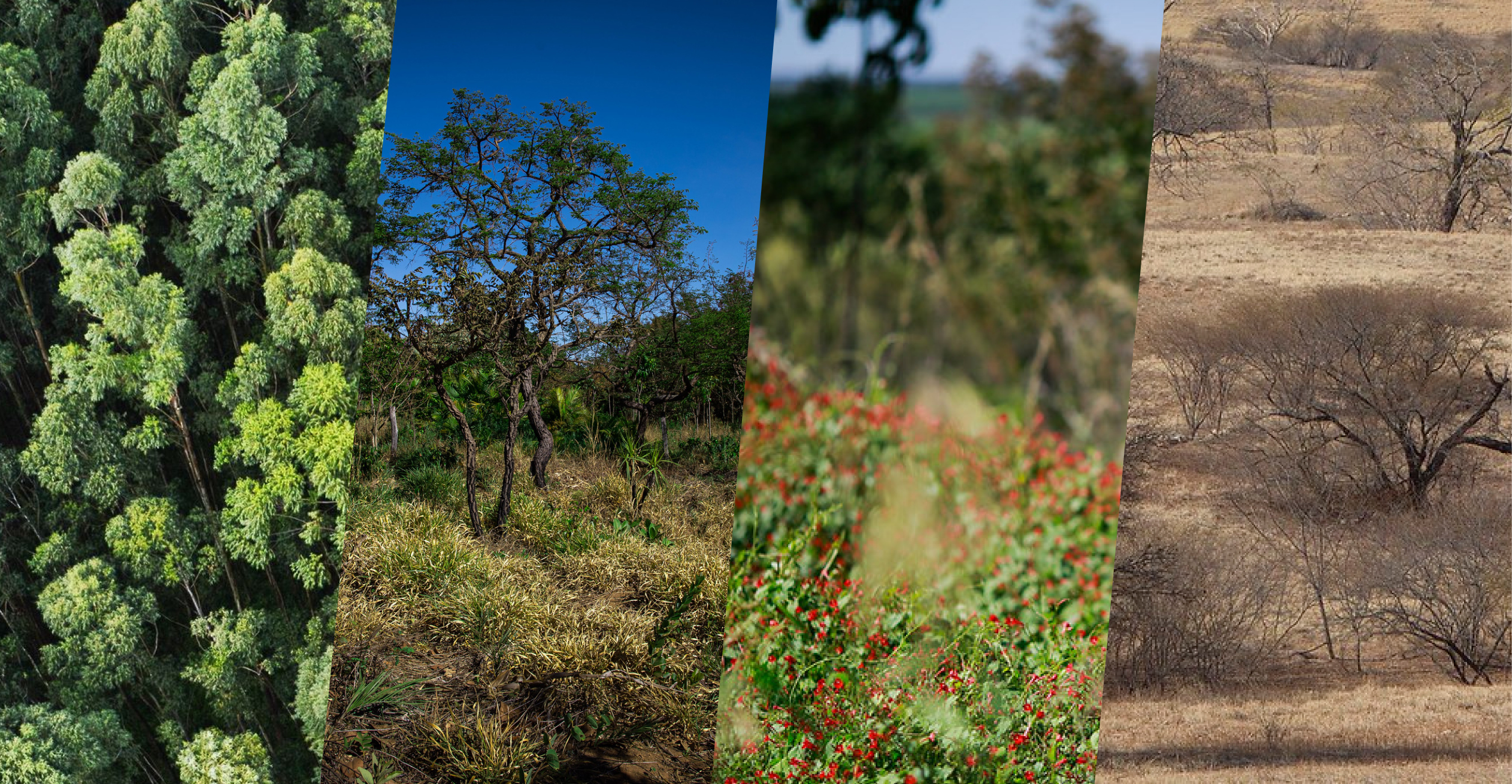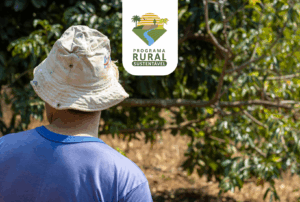Programa Rural Sustentável
Contributing to a low-carbon transition in Brazilian agriculture
ABOUT THE PROGRAM
The Sustainable Rural Program contributes to a transition in agriculture in Brazil’s main biomes. We seek to restore deforested and degraded lands on small and medium-sized properties to improve productivity. This is possible through the use of low-carbon agricultural production practices and social technologies, while avoiding illegal deforestation and pressure to expand new productive areas. There are 62.3 million euros allocated to this great objective. We show, in practice, that it is possible to do more and better with the area already used by traditional agriculture.
We are present in 21% of the Brazilian territory, in an area of 1.7 million km², operating in 252 municipalities. For comparison purposes, this coverage corresponds to the sum of the extension of countries such as Portugal, Spain, France, Italy, Switzerland, Greece and Belgium.

2012
Home: Amazon and Atlantic Forest biomes
This is where it all began: Phase 1 of the PRS, which lasted until 2019. The objective was to improve land and forest management by farmers in the Amazon and Atlantic Forest biomes, leveraging sustainable rural development, reducing poverty in rural areas, conserving biodiversity and protecting the climate.

2019
Beginnings of operations in the Caatinga and Cerrado
Based on the successful experience in Phase 1 and seeking to overcome the challenges of the lessons learned, we seek to implement sustainable production practices in harmony with the territory. The PRS – Caatinga and PRS – Cerrado begin, which will last until 2023.
In both biomes, the aim is to promote sustainable and profitable production techniques for low-carbon agriculture. Knowledge is developed together with communities, respecting the vocation of the land and improving productive technologies.

2021
Start of extension to the Amazon biome
Based on the achievements of Phase 1 of the PRS, the extension in the Amazon biome will launch in 2021, with the aim of developing sustainable value chains. The project is aimed at socio-productive organizations, working the entire production chain, from primary production and product processing, to commercialization and sustainable certification.

2023
End of operations in the Caatinga and Cerrado biomes
After 4 years of implementation, the PRS ends its operations in the Caatinga and Cerrado biomes. It is expected to increase the income of up to 25% of benefited rural producers, with more than 28 million tons of greenhouse gas emissions reduced through avoided deforestation and with more than 3 thousand rural properties adopting practices sustainable agriculture.

End of Sustainable Rural
This year marks the end of the extension in the Amazon and, thus, the end of the PRS’s activities. In this biome alone, 2 thousand hectares of deforestation are expected to be avoided, 600 families of small producers/extractors who improve their production practices, 15 socio-productive organizations strengthened and 6 thousand hectares of land managed sustainably.
BENEFITS OF LOW CARBON FARMING
Agriculture is understood as the combination of agriculture and livestock. In addition to traditional practices, several technologies can be implemented to increase soil productivity and resilience, while reducing pressure to expand new areas, combating illegal deforestation and living in harmonious coexistence with the territory.
An effective transition to sustainable agriculture and livestock farming is possible!
The Sustainable Rural Program contributes to boosting agricultural production through sustainable means. It enables a significant increase in the productive area of critical ecosystems, such as the Amazon, as they are effectively protected and restored when they integrate sustainable management practices to reduce emissions, build climate resilience and combat poverty in rural areas.
And Brazilian agriculture has been taking several actions to reduce environmental impact, such as adopting new technologies and management alternatives or integrating different systems in the same area. In this context, Sustainable Rural presents itself as an instrument to protect biodiversity and boost positive results in nature, as it seeks to:
Protect, restore and manage natural resources sustainably to increase the resilience of ecosystems and the services they provide.
Act in accordance with the productive vocation of each territory and reduce the causes of biodiversity loss and ecosystem degradation.
Enhance the value of nature and its use in a sustainable way, generating institutional and decision-making changes by actors of change at local level, subnational governments, the financial system, businesses and individuals.
HOW WE ACT
GENERAL OBJECTIVE
Conserve natural biodiversity resources and avoid illegal deforestation by increasing productivity and profitability in the sustainable use of land, reducing poverty in rural areas.
MAIN OBJECTIVES
People
- Increase the income of rural producers;
- Improve access to incentives for sustainable development.
Nature and use of land
- Leverage the use of sustainable production systems, with gains in biodiversity and conservation of natural resources;
- Promote the maintenance of ecosystem services and the conservation of biodiversity through actions to restore degraded landscapes;
- Promote the training of rural producers to consolidate low-carbon agriculture.
Climate
- Transform traditional production methods to a more sustainable and resilient agricultural sector to climate change;
- Reduce GHG emissions through the restoration of anthropic areas and environmental protection.
LOW CARBON EMISSION TECHNOLOGIES
The Crop-Livestock-Forest Integration systems (ILPF), understood as Agroforestry Systems (SAFs), and the Recovery of Degraded Pastures (RPD) are production strategies. The first integrates different agricultural, livestock and forestry activities in the same area, in intercropped cultivation, in succession or in rotation, seeking synergistic effects between its components, considering environmental suitability and economic viability. RPD consists of techniques that promote the recovery of the productive capacity of degraded pastures, providing an increase in the productivity of forage species.
- INTEGRATED SYSTEMS improve livestock farming, farming and keep the forest standing.
- RECOVERY OF DEGRADED AREAS restores soil cover and the vigor of forage plants existing in the pasture impact


SOCIAL TECHNOLOGIES
They are reapplicable products, techniques or methodologies, developed in interaction with communities and that represent effective solutions for social transformation on a large scale.
We recognize the Caatinga as an open-air laboratory that creates, systematizes and promotes exchanges between the knowledge of rural producers and the experience of social organizations in dialogue with technical and scientific knowledge developed in the region.
Goals for phase II
PRS – Caatinga
- 1,500 rural producers mobilized
- 600 hectares of sustainable management
- 200 hectares of preserved area in private property
- + 15% improvement in family income
- +120 trained ATER professionals
- 200 hectares of restored area
- 20 million tons of CO2 avoided
- Adoption of innovative social technologies in energy and water
- Publication of the collection Cadernos do PRS Caatinga, with research results on environmental and social conditions and the impact of low-carbon technologies for their restoration and conservation;
- In partnership with UNIVASF, it promotes a lato sensu course in low-carbon agricultural technologies, with 600 enrollees, aimed at qualifying ATER services;
- Performs Land Use and Hydrography mapping using high-resolution satellite images;
- Promotes the strengthening of various stakeholder networks, including the formation of a Territorial Technical Committee that brings together representatives from different sectors operating in the Caatinga.
PRS – Cerrado
- + than 16 thousand people benefited
- 4,500 rural producers trained
- 1,500 rural producers with access to improved credit
- 300 thousand hectares implemented with low carbon emission technologies
- 3 thousand Multiplier Units supported
- 170 Demonstration Units identified
- 20 socio-productive organizations strengthened
- 33 supported research
Professional Master’s Degree in partnership with the Federal University of Lavras (UFLA) in ABC - Distance Learning Course in partnership with Canal Futura, from the Roberto Marinho Foundation
- Use of innovative financial instruments in Green Finance, to leverage rural credit, carbon credits and with the potential to be replicated in other biomes
Attendance at mobilization training actions
- 9 thousand rural producers
- 7,800 young people
- 1,750 ATER professionals
PRS – Amazônia (extensão)
- 400 thousand tons of GHG emissions mitigated by avoided deforestation
- 15% increase in annual gross family income
- 10% increase in productivity
- 600 producer/extractivist families adopting sustainable production practices
Results achieved in Phase I
Amazônia
- Around R$24 million reais disbursed directly to rural producers
- 1,559 Multiplier Units supported
- 17,922 participants in training actions
- 3 face-to-face training sessions carried out with Technical Assistance and Rural Extension Agents (ATECs)
- 133 Demonstration Units
Mata Atlântica
- More than R$19 million reais disbursed directly to rural producers
- 1,984 Multiplier Units supported
- 22,677 participants in training actions
- 4 face-to-face training sessions carried out with ATECs
- 218 Demonstration Units
WHERE WE ACT

Amazônia
Biome characterization
- Presence of traditional, riverside and quilombola communities.
- Structuring value chains (such as round fish, coffee, açaí, Brazil nuts and cocoa), + increased productivity and of income.
How the program works (extension)
- Present in 109 municipalities.
- The focus is to prevent illegal deforestation by supporting chains sustainable production of açaí, coffee, fish, nuts and cocoa, which enables an increase in income and productivity;
- It will promote the development of production, economic and environmentally sustainable, based on adding value to Amazonian products, technical assistance and strengthening socio-productive organizations.
Cerrado
Biome characterization
- Largest grain producer in the country.
- Intensification of sustainable production (reduction of pressure to opening of new productive areas).
How the program works
- Effective transition to sustainable agriculture, empowering almost 10 thousand people and driving transformation at scale, in 4 states and 101 municipalities.
- Enables the application of incentives for the adoption of good resilient environmental management practices and, at the same time, profitable.
- Master’s course with the Federal University of Lavras (UFLA) in ABC;
- Distance Learning Course in partnership with Fundação Roberto Marine;
- 20 socio-productive organizations strengthened;
- 300 thousand hectares implemented with low carbon technologies;
- + 16 thousand people benefited;
- 4,500 rural producers trained
- It will use innovative financial instruments, such as SAFF, to leverage rural credit, carbon credits and potential to replicate in other biomes.
Caatinga
Biome characterization
- The only exclusively Brazilian biome, strategic in relation to biodiversity.
- Predominantly family-based agriculture, developed in minifundios.
How the program works
- Present in 5 Brazilian states, with 37 municipalities.
- It works to strengthen 20 Local Production Arrangements with the implementation of low-carbon agricultural technologies, dialoguing with the priorities of AgroNordeste public policy;
- Promotes sustainable strategies for food production reconciling soil conservation and land transformation degraded into arable land to stop the advancement of the process of desertification;
- Benefits 1,725 people, with the adoption of social technologies innovators in energy and water;
- In partnership with UNIVASF, a lato sensu course in technologies low-carbon agriculture, with 600 registered, aimed at qualification of ATER services;
- Mapping of Land Use and Hydrography from images of high resolution satellite;
- Strengthening diverse stakeholder networks, including formation of a Territorial Technical Committee that brings together representatives from different sectors operating in the Caatinga.
Mata Atlântica
Biome characterization
- Composed of a set of forests and ecosystems that corresponds to 15% of the Brazilian territory, forming a dense and closed forest;
- In addition to being present in 17 Brazilian states, it also covers a part of Paraguay and Argentina.
How the program worked
- The Atlantic Forest biome constituted a special challenge, covering extremely varied areas from the point of view biophysical and socioeconomic, ranging from the South to the Northeast Brazilian. The Program’s activities revolved around the application of varied sustainable technologies, providing technical assistance and rural extension, improving land and forest management.
WHO WE ARE
We are financed by Technical Cooperation approved by the Inter-American Development Bank (IDB), with resources from the United Kingdom Government’s International Climate Financing, with the Ministry of Agriculture, Livestock and Supply (MAPA) as the institutional beneficiary. We operate in the Cerrado and Amazon biomes, run and managed by the Brazilian Institute for Development and Sustainability (IABS), and in the Caatinga biome, run and managed by the Brazilian Foundation for Sustainable Development (FBDS). In the first phase of the Program, we developed work in the Amazon and Atlantic Forest biomes.

In a broader context, the Program dialogues directly with major structuring Brazilian public policies, with emphasis on the sectoral Plan for Adaptation to Climate Change and Low Carbon Emissions in Agriculture with a view to Sustainable Development, ABC+, and as a sectoral instrument for compliance with the Nationally Determined Contribution (NDC).
Action in biomes is also connected with specific public policies for the respective territories. Two biomes stand out: in the Caatinga, the PRS dialogues with AgroNordeste; In the Amazon, the PRS leverages the promotion of productive landscapes with extractivism (wild collection) and low-carbon agricultural methods, with the aim of ensuring environmental, social and economic resilience, while reducing the need for vegetation conversion native, consequently reducing illegal deforestation and soil degradation in the Amazon. The PRS – Amazônia, by intervening in three municipalities (Lábrea, São Félix do Xingú and Altamira), which are also priority municipalities of the National Council for the Legal Amazon, headed by the Vice-President of the Republic, Hamilton Mourão.
Furthermore, we dialogue directly with the Águas do Agro policy, which promotes sustainable economic development in rural areas through the adoption of soil and water conservation measures and practices, with efficient management of natural resources. The focus of this policy is on micro river basins and the strengthening of sustainable technologies for water and soil use.
Tangentially, we can mention the dialogue between Sustainable Rural and the National Soil Survey and Interpretation Program in Brazil (PronaSolos). After all, Rural reaches such a large territory and locations of such comprehensive sizes, soil characteristics and biodiversity, that the connection with PronaSolos can deepen even further. There are also efforts by the Brazilian government to build the PronaSolos Platform, which will gather information on Brazilian soil. The data can be accessed by researchers, rural producers and the general population, free of charge.

The largest Brazilian policy aimed at low-carbon agriculture
BRAZILIAN NDC: Nationally Determined Contribution
Obtaining concrete results aimed at the low-carbon economy
Synergy with public policies beyond ABC+



EXPECTED RESULTS
Operations in the Caatinga, Cerrado and Amazon extension biomes
Reduce emission
of about
29M tons
Reduce emissions
of about
Handle properly
sustainable
306.800 ha
of land
Increase of up to
25%
income of rural producers in intervention areas
Reduction in pressure to deforest new areas, with almost
50.000 ha
of land under sustainable management, directly avoiding
the deforestation in 805.50 ha
Increase of up to
10%
in productivity, in sustainable chains in the Amazon
Avoid deforestation
in an area of
132.000 ha
Benefit about
30 mil
people
NEWS

Proteger o Cerrado para garantir o acesso à água no Brasil

Agricultura de baixo impacto ambiental é exemplo de produção eficiente e sustentável

PRS – Cerrado realiza missão no estado de Goiás

Confira a jornada de aprendizagem do PRS – Cerrado com ATECs em agosto

Conservar as águas amazônicas para garantir o equilíbrio climático

No Dia da Amazônia, conheça as ações do PRS – Amazônia













